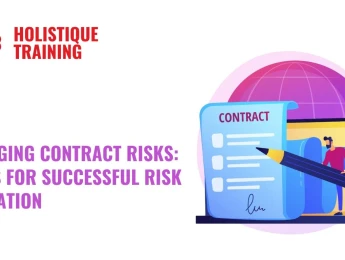- Table of Contents
- Introduction
- What is Contract Risk Management?
- Benefits of Contract Risk Management
- 1. Prevention of Financial Losses
- 2. Enhanced Compliance
- 3. Improved Performance
- 4. Protection of Reputation
- 5. Stronger Business Relationships
- 6. Efficient Dispute Resolution
- 7. Strategic Decision-Making
- 8. Better Resource Allocation
- Difference Between Contract Management & Contract Risk Management
- Types of Contract Risks
- 1. Financial Risks
- 2. Regulatory Risks
- 3. Performance Risks
- 4. Legal Risks
- 5. Brand Risks
- 6. Security Risks
- The Contract Risk Management Process
- 1. Risk Identification
- 2. Risk Assessment
- 3. Risk Mitigation
- 4. Risk Monitoring
- 5. Risk Resolution
- Creating a Plan for Contract Disputes
- 1. Dispute Resolution Mechanisms
- 2. Clear Communication Channels
- 3. Detailed Procedures for Filing Complaints
- 4. Timelines for Dispute Resolution
- 5. Escalation Procedures
- 6. Documentation Requirements
- 7. Involvement of Legal Counsel
- 8. Cost Management
- 8 Tips to Stay Safe Against Contract Risks
- 1. Thoroughly Review and Understand Contract Terms
- 2. Conduct Due Diligence on All Parties Involved
- 3. Include Clear and Detailed Contract Clauses
- 4. Implement a Risk Management Plan
- 5. Establish Clear Communication Channels
- 6. Use Contract Management Tools
- 7. Regularly Monitor Contract Performance
- 8. Have a Dispute Resolution Plan in Place
- The Importance of Contract Management Tools
- Automated Alerts and Notifications:
- Enhanced Visibility:
- Improved Collaboration:
- Data Analytics:
- Risk Assessment and Mitigation:
- In conclusion
Introduction
Contracts are the backbone of business agreements, defining the terms and expectations between parties. However, they also come with inherent risks that can lead to significant challenges if not managed properly. Contract risk management is a critical process that involves identifying, assessing, and mitigating these risks to ensure that contracts are executed smoothly and disputes are minimised. By implementing effective risk management strategies, businesses can safeguard themselves against potential pitfalls and maintain strong, successful relationships with their partners. This blog post delves into the essential aspects of contract risk management, offering practical tips and insights to help you navigate and manage contract-related risks effectively.
What is Contract Risk Management?
Contract risk management involves identifying, assessing, and mitigating risks associated with contractual agreements. It is a systematic approach to protecting businesses from potential contract losses and disputes. This process encompasses various strategies and tools aimed at managing the complexities of contract execution and ensuring that all parties adhere to the agreed terms. By proactively addressing potential risks, organisations can avoid costly disputes and maintain healthy business relationships.
Benefits of Contract Risk Management
Contract risk management is not merely a precautionary measure but a strategic approach offering significant business advantages. Here’s an in-depth look at the key benefits:
1. Prevention of Financial Losses
One of the foremost benefits of contract risk management is its role in safeguarding against financial losses. Contracts are financial instruments that can carry significant monetary implications. Effective risk management helps identify potential financial risks before they become severe issues, such as payment defaults, cost overruns, and unanticipated expenses. By proactively addressing these risks, businesses can implement strategies to avoid costly litigation, penalties, and compensation claims. For example, including clear payment terms and penalty clauses in contracts can prevent disputes over financial obligations and mitigate any financial risks.
2. Enhanced Compliance
Compliance with legal and regulatory requirements is a critical aspect of business operations. Contract risk management ensures that contracts adhere to relevant laws and regulations, reducing non-compliance risk. Non-compliance can lead to legal penalties, fines, and damage to the company’s reputation. By incorporating compliance checks and balances into contract management, businesses can avoid legal pitfalls and meet all necessary regulatory requirements. This proactive approach helps maintain good standing with regulatory authorities and avoids compliance breaches' financial and operational impact.
3. Improved Performance
Effective contract risk management enhances organisational performance by clarifying terms and responsibilities. When contracts are well-managed, all parties clearly understand their obligations, deadlines, and performance metrics. This clarity helps prevent misunderstandings and disputes, which can disrupt business operations. For instance, specifying performance standards and deliverables in the contract ensures that all parties are aligned with expectations, leading to smoother execution and improved outcomes. As a result, businesses can achieve their goals more efficiently and maintain higher operational performance.
4. Protection of Reputation
A company’s reputation is one of its most valuable assets; contract-related disputes or failures can significantly damage it. Effective contract risk management helps protect the company’s brand and public image by preventing issues that could lead to negative publicity or customer dissatisfaction. For example, managing risks associated with contract performance and compliance can prevent situations that might result in public disputes or media coverage. By maintaining positive relationships and fulfilling contractual obligations, businesses can enhance their reputation and build trust with clients, partners, and stakeholders.
5. Stronger Business Relationships
Building and maintaining strong business relationships is crucial for long-term success. Effective contract risk management fosters trust and cooperation between parties by ensuring that agreements are clear, fair, and consistently enforced. Managing risks proactively reduces the likelihood of conflicts and disputes, leading to smoother interactions and stronger partnerships. For example, addressing potential risks and setting up clear contract dispute resolution mechanisms can help resolve issues amicably and maintain positive relationships. This collaborative approach contributes to a more stable and productive business environment.
6. Efficient Dispute Resolution
Having a structured approach to contract risk management facilitates efficient dispute resolution. When disputes arise, a well-defined risk management plan helps address them promptly and effectively. This includes having clear procedures for dispute resolution, such as mediation or arbitration, outlined in the contract. By managing disputes efficiently, businesses can minimise the impact on operations and avoid prolonged legal battles. This proactive approach to resolving conflicts saves time and resources and helps maintain a positive business environment.
7. Strategic Decision-Making
Contract risk management provides valuable insights that support strategic decision-making. Businesses can make informed decisions about contract negotiations, performance expectations, and risk mitigation strategies by analysing risks and their potential impact. For example, understanding the financial implications of various risks allows businesses to negotiate better terms and implement strategies that align with their risk tolerance and business objectives. This strategic approach enhances overall decision-making and contributes to more effective management of business risks.
8. Better Resource Allocation
Effective contract risk management helps optimise resource allocation by identifying potential risks and their impact on resources. By addressing risks early, businesses can allocate resources more efficiently and avoid over-commitment or underutilization. For example, managing risks associated with contract performance ensures that resources are allocated to projects and activities that align with contractual obligations and business priorities. This efficient resource management contributes to overall operational effectiveness and helps achieve business goals more effectively.
In summary, contract risk management offers numerous benefits that go beyond mere risk avoidance. It helps prevent financial losses, ensure compliance, improve performance, protect reputation, strengthen relationships, resolve disputes efficiently, support strategic decision-making, and optimise resource allocation. By implementing effective contract risk management practices, businesses can safeguard their interests, enhance operational efficiency, and achieve long-term success.
Difference Between Contract Management & Contract Risk Management
While contract management and contract risk management are closely related, they serve different purposes. Contract management involves overseeing the creation, execution, and evaluation of contracts to ensure compliance with terms and conditions. It focuses on the administrative aspects of contracts, including negotiation, execution, and performance monitoring.
On the other hand, contract risk management explicitly addresses the potential risks associated with contracts. It involves identifying, analysing, and mitigating risks that could impact the contract's successful execution. While contract management ensures that contracts are administered effectively, contract risk management minimises the likelihood and impact of adverse events related to contracts.
Types of Contract Risks
Understanding the types of contract risks is essential for effective risk management. Here are some common contract risks:
1. Financial Risks
Financial risks pertain to potential monetary losses or complications arising from contract-related issues. These risks can affect a company’s financial stability and operational efficiency. Key examples include:
- Payment Defaults: When one party fails to make payments as stipulated in the contract, it can lead to cash flow issues and financial strain. This risk is especially significant in contracts involving large sums or long-term commitments.
- Cost Overruns: Unexpected cost increases due to scope changes, inefficiencies, or unforeseen expenses can result in financial losses. Contracts without clear cost definitions or change management procedures are particularly vulnerable to this risk.
- Currency Fluctuations: In international contracts, fluctuations in currency exchange rates can impact financial outcomes. Contracts involving multiple currencies must address how currency risks are managed to prevent financial discrepancies.
- Budget Constraints: A contract not well-aligned with the available budget can lead to financial difficulties. Effective financial planning and budget management are essential to mitigate this risk.
The contract must include clear payment terms, cost controls, and financial guarantees to manage financial risks. Regular financial monitoring and audits can also help identify and address potential issues early.
2. Regulatory Risks
Regulatory risks involve non-compliance with laws, regulations, and industry standards that govern contractual agreements. These risks can lead to legal penalties, fines, and operational disruptions. Key aspects include:
- Legal Compliance: Failure to comply with local, national, or international regulations can result in legal consequences. For example, contracts that do not adhere to labour laws or environmental regulations can face legal challenges.
- Regulatory Changes: Changes in regulations or laws during the contract term can impact compliance. To mitigate this risk, contracts should include provisions for adapting to regulatory changes.
- Industry-Specific Regulations: Certain industries have specific regulatory requirements that must be adhered to. For example, healthcare or financial services contracts often have stringent compliance standards.
To address regulatory risks, businesses should review contracts to ensure compliance with applicable laws and regulations. Engaging legal experts and incorporating compliance clauses can help manage these risks effectively.
3. Performance Risks
Performance risks relate to the potential failure of a party to meet the agreed-upon terms and conditions of the contract. These risks can impact the contract's quality, timeliness, and overall success. Key considerations include:
- Delivery Delays: If a party fails to deliver goods or services on time, it can disrupt operations and cause financial losses. The contract should specify clear deadlines and penalties for delays.
- Quality Issues: Substandard quality of goods or services can lead to dissatisfaction and additional costs. Contracts should include quality standards and inspection procedures to ensure performance meets expectations.
- Incomplete Deliverables: If the scope of work is not clearly defined, there is a risk of incomplete or inadequate deliverables. Detailed specifications and milestones can help in managing this risk.
To mitigate performance risks, it is essential to set clear performance metrics, deadlines, and quality standards in the contract. Regular performance reviews and inspections can also help monitor and address performance issues.
4. Legal Risks
Legal risks involve potential legal disputes and liabilities arising from contract breaches, ambiguities, or enforceability issues. These risks can result in costly litigation and reputational damage. Key aspects include:
- Breach of Contract: A party failing to fulfil their contractual obligations can lead to legal disputes. Contracts should include breach of contract clauses and remedies to address such situations.
- Ambiguities: Ambiguous or vague contract terms can lead to misunderstandings and disputes. Ensuring that all terms are clear and specific can help in preventing legal issues.
- Enforceability: Contracts that are not legally enforceable or are invalid due to improper drafting can result in legal challenges. Consulting legal experts during contract drafting can help in ensuring enforceability.
Research from organisations such as World Commerce & Contracting, as mentioned by Profile Tree, reveals that on average, 9.2% of annual revenue is lost due to missed deadlines, overlooked clauses, and unmet obligations. To manage legal risks, it is important to work with legal professionals to draft and review contracts. Including clear terms, dispute resolution mechanisms, and legal compliance provisions can help in mitigating these risks.
5. Brand Risks
Brand risks pertain to potential damage to a company’s reputation and public image resulting from contractual issues. These risks can impact customer trust and brand value. Key considerations include:
- Negative Publicity: Disputes or failures related to contracts can generate negative publicity that affects the company’s reputation. Managing contract performance and addressing issues promptly can help in mitigating this risk.
- Customer Dissatisfaction: If contractual obligations related to product or service quality are not met, customer dissatisfaction can result and harm the brand’s reputation. Ensuring high standards and effectively addressing customer concerns is crucial.
- Partner Associations: The behaviour or performance of contract partners can impact the company’s brand. Selecting reliable and reputable partners can help in managing brand risks.
To protect the brand, businesses should focus on maintaining high standards of performance, addressing issues proactively, and managing public relations effectively.
6. Security Risks
Security risks involve potential threats to data, intellectual property, and other sensitive information related to contractual agreements. These risks can lead to data breaches, theft, and loss of confidential information. Key aspects include:
- Data Breaches: Contracts that handle sensitive data must address data protection and security measures. Inadequate security measures can lead to data breaches and legal consequences.
- Intellectual Property Theft: Intellectual property contracts should include provisions for protecting proprietary information. Risks of intellectual property theft or misuse should be managed through confidentiality agreements and security measures.
- Cybersecurity Threats: Cybersecurity risks are growing as contracts increasingly involve digital transactions and communications. Implementing robust cybersecurity measures and protocols can help mitigate these risks.
Businesses should incorporate data protection and confidentiality clauses in contracts to manage security risks. Regular security audits and implementing cybersecurity best practices can also help safeguard sensitive information.
In summary, understanding and addressing the various types of contract risks—financial, regulatory, performance, legal, brand, and security—are essential for effective contract risk management. By identifying these risks and implementing appropriate mitigation strategies, businesses can protect themselves from potential issues and ensure successful contract execution.
The Contract Risk Management Process
Effectively managing contract risks involves a structured process integrating risk identification, assessment, and mitigation strategies. This process ensures that potential issues are addressed proactively and that contracts are executed smoothly. Here’s a comprehensive look at each stage of the contract risk management process:
1. Risk Identification
The first step in the contract risk management process is identifying potential risks associated with a contract. This involves thoroughly examining the contract’s terms and conditions, the parties involved, and the contract's context. Key activities in this stage include:
- Reviewing Contract Terms: Carefully scrutinise the contract for any ambiguities, uncertainties, or provisions that could pose risks. Look for clauses related to payment terms, delivery schedules, quality standards, and compliance requirements.
- Analysing Stakeholder Inputs: Engage with stakeholders, including project managers, legal advisors, and finance teams, to gather insights on potential risks. Their expertise can help identify risks that might not be immediately apparent.
- Considering External Factors: Evaluate external factors that could impact the contract, such as regulatory changes, market conditions, and geopolitical issues. Understanding these factors helps identify risks that could affect the contract’s performance.
- Using Risk Assessment Tools: Employ risk assessment tools and techniques, such as checklists, risk matrices, and historical data analysis, to identify potential risks systematically. These tools provide a structured approach to risk identification.
2. Risk Assessment
Once potential risks are identified, the next step is to assess their likelihood and potential impact. Risk assessment involves evaluating the significance of each risk and prioritising them based on their potential effect on the contract. Key activities in this stage include:
- Evaluating Likelihood and Impact: Assess the probability of each risk occurring and its potential impact on the contract’s objectives. This can be done through qualitative methods (e.g., expert judgement) or quantitative methods (e.g., statistical analysis).
- Prioritising Risks: Rank the identified risks based on their likelihood and impact. Prioritisation helps in focusing attention and resources on the most significant risks. High-priority risks are those with a high probability of occurrence and a severe impact on the contract.
- Documenting Risks: Create a risk register or risk log to document the identified risks, their assessment results, and any relevant details. This document serves as a reference for risk management and monitoring throughout the contract lifecycle.
- Assessing Risk Tolerance: Determine the organisation’s risk tolerance level—how much risk the organisation is willing to accept. This helps in aligning risk management strategies with the organisation’s risk appetite and business objectives.
3. Risk Mitigation
With risks identified and assessed, the next step is to develop and implement strategies to mitigate or manage those risks. Risk mitigation involves planning and executing measures to reduce the likelihood or impact of risks. Key activities in this stage include:
- Developing Mitigation Strategies: Formulate strategies to address each identified risk. This may include risk avoidance (e.g., altering the contract terms), risk reduction (e.g., implementing control measures), risk transfer (e.g., using insurance or subcontracting), and risk acceptance (e.g., acknowledging and preparing for the risk).
- Incorporating Risk Mitigation into Contracts: Embed risk mitigation measures into the contract terms and conditions. For example, include clauses for performance guarantees, penalties for non-compliance, and provisions for change management.
- Implementing Control Measures: Establish and execute control measures to manage risks. This could involve regular monitoring, audits, and inspections to ensure that risk mitigation strategies are effectively applied.
- Communicating Risk Mitigation Plans: Share risk mitigation plans with relevant stakeholders to ensure alignment and coordination. Clear communication helps manage expectations and ensure that all parties understand their roles in risk management.
4. Risk Monitoring
Continuous monitoring of risks is essential to ensure that the risk management strategies remain effective throughout the contract’s lifecycle. Risk monitoring involves tracking identified risks, detecting new risks, and assessing the effectiveness of mitigation measures. Key activities in this stage include:
- Regular Risk Reviews: Review the risk register and risk mitigation strategies regularly. This helps identify any changes in risk status and evaluate the effectiveness of the implemented measures.
- Monitoring Risk Indicators: Track key risk indicators and performance metrics to detect early signs of potential issues. For example, monitoring financial performance, compliance metrics, and project milestones can provide insights into emerging risks.
- Adjusting Risk Management Strategies: Based on monitoring results, adjust risk management strategies as needed. If new risks arise or existing risks change, update the risk mitigation plans to address the evolving risk landscape.
- Reporting on Risks: Provide regular risk reports to stakeholders, including senior management and project teams. These reports should include updates on risk status, mitigation efforts, and any significant changes in risk conditions.
5. Risk Resolution
When risks materialise, it’s important to have a plan for resolving issues promptly and effectively. Risk resolution involves managing and addressing risks as they occur to minimise their impact. Key activities in this stage include:
- Implementing Contingency Plans: Activate contingency plans that outline steps to address specific risks if they materialise. Contingency plans should be well-defined and practised to ensure a swift response.
- Resolving Disputes: Address and resolve any disputes or issues that arise from contract risks. This may involve negotiation, mediation, or arbitration to reach a resolution that satisfies all parties.
- Learning from Incidents: Analyse any risk-related incidents or issues to identify lessons learned. Document and use these insights to improve future risk management practices and contract processes.
- Updating Risk Management Plans: Revise risk management plans based on the outcomes of risk resolution efforts. Incorporate any new insights or changes to enhance the effectiveness of future risk management strategies.
In short, the contract risk management process involves a systematic approach to identifying, assessing, mitigating, monitoring, and resolving contract risks. By following these steps, businesses can proactively manage potential issues, ensure successful contract execution, and achieve their objectives while minimising disruptions and adverse impacts.
KPI | Description |
Risk Identification Rate | Frequency of identified contract risks |
Resolution Time | Average time to resolve identified risks |
Compliance Rate | Percentage of contracts meeting compliance |
Dispute Frequency | Number of disputes per contract |
Contract Performance Metrics | Performance against agreed contract terms |
Table: KPIs of Contract Risk Management
Creating a Plan for Contract Disputes
A well-defined plan for managing contract disputes is crucial for resolving conflicts efficiently and minimising their impact. Here are key elements to consider when creating a dispute resolution plan:
1. Dispute Resolution Mechanisms
Dispute resolution mechanisms are formal processes the contract outlines to address conflicts between parties. These mechanisms include methods such as negotiation, mediation, and arbitration. By specifying these methods in the contract, parties can ensure a structured approach to resolving disputes. For example, mediation involves a neutral third party who helps facilitate a resolution, while arbitration provides a binding decision from an arbitrator. Including these mechanisms helps streamline the resolution process and avoid lengthy litigation.
2. Clear Communication Channels
Establishing clear communication channels is essential for effective dispute resolution. The contract should specify how and to whom disputes should be reported and addressed. This includes defining contact points for dispute resolution and the procedures for escalating issues. Clear communication channels ensure that all parties know whom to approach and how to formally raise concerns, thereby reducing misunderstandings and facilitating a smoother resolution process. Timely and clear communication can prevent minor issues from escalating into major disputes.
3. Detailed Procedures for Filing Complaints
Detailed procedures for filing complaints ensure that disputes are addressed systematically. The contract should outline the steps for initiating a dispute, including the required documentation and timelines. This may involve submitting written notices, providing evidence, and following specific protocols for complaint submission. Clear procedures help organise the dispute resolution process and ensure all relevant information is provided. This structured approach facilitates a more efficient resolution and reduces the potential for procedural errors.
4. Timelines for Dispute Resolution
Timelines for dispute resolution are crucial for ensuring that conflicts are addressed promptly. The contract should specify timeframes for each stage of the dispute resolution process, from the initial complaint to the final resolution. This includes deadlines for filing disputes, responding to claims, and reaching a resolution. Timely resolution prevents disputes from lingering and impacting business operations. Establishing clear timelines helps maintain momentum in resolving issues and minimises delays.
5. Escalation Procedures
Escalation procedures outline the steps for escalating disputes if initial resolution efforts are unsuccessful. The contract should define the escalation levels, including when and how to involve higher management or external mediators. This may involve escalating from internal negotiations to mediation, arbitration, or litigation if necessary. Clearly defined escalation procedures ensure that disputes are addressed appropriately and provide a path for resolution if initial attempts fail. This structured approach helps resolve conflicts more effectively and prevents them from stalling progress.
6. Documentation Requirements
Documentation requirements involve maintaining accurate records of all dispute-related communications and proceedings. The contract should specify the required documentation, such as written notices, evidence, and correspondence related to the dispute. Proper documentation supports the dispute resolution process by clearly recording events and communications. This helps establish the facts of the case and provides a basis for resolving the dispute. Thorough documentation also aids in future reference and potential legal proceedings.
7. Involvement of Legal Counsel
The involvement of legal counsel ensures that disputes are handled with appropriate legal expertise. The contract should address the role of legal counsel in the dispute resolution process, including when to seek legal advice and how to engage legal professionals. Legal counsel can guide legal rights, obligations, and potential outcomes, helping parties navigate complex disputes. Their involvement helps ensure that the dispute resolution process is legally sound and that parties are adequately represented.
8. Cost Management
Cost management involves planning for and controlling the expenses associated with dispute resolution. The contract should outline how costs will be allocated, including fees for legal counsel, mediation, arbitration, or litigation. Clear provisions for cost management help prevent disputes over financial responsibilities and ensure that parties are prepared for the potential expenses of resolving conflicts. Budgeting for these costs and establishing how they will be shared helps manage financial risks and avoid disputes over financial matters.
In summary, creating a plan for contract disputes involves specifying dispute resolution mechanisms, establishing clear communication channels, detailing complaint procedures, setting timelines, defining escalation procedures, outlining documentation requirements, involving legal counsel, and managing costs. Businesses can effectively manage and resolve disputes by addressing these aspects, minimising disruptions and maintaining positive relationships throughout the contract term.
8 Tips to Stay Safe Against Contract Risks
Effective management of contract risks involves proactive strategies and best practices to minimise potential issues and ensure successful contract execution. Here are eight tips to help you stay safe against contract risks:
1. Thoroughly Review and Understand Contract Terms
A comprehensive review of contract terms is crucial for identifying and understanding potential risks. This involves reading each clause carefully, ensuring clarity on obligations, rights, and responsibilities. Pay particular attention to terms related to payment schedules, deliverables, and termination conditions. Understanding these terms helps spot any ambiguities or potential issues that could lead to disputes. Engaging legal counsel to review complex contracts can also help identify risks and ensure that all terms are clear and enforceable.
2. Conduct Due Diligence on All Parties Involved
Performing due diligence on all parties involved in the contract is essential for assessing their reliability and capability. This includes researching their financial stability, reputation, and past performance. Verify their compliance with relevant regulations and industry standards. A thorough background check helps identify potential risks associated with the counterparty, such as financial instability or a poor performance history. Choosing reliable and reputable partners reduces the likelihood of encountering issues during the contract term.
3. Include Clear and Detailed Contract Clauses
Including clear and detailed clauses in the contract helps minimise ambiguity and prevent misunderstandings. Clearly define the scope of work, performance standards, payment terms, and deadlines. Specify the procedures for handling changes, disputes, and terminations. Detailed clauses ensure that all parties mutually understand their obligations and reduce the risk of conflicts. Avoid vague language and ensure that all important aspects of the agreement are addressed explicitly.
4. Implement a Risk Management Plan
Developing and implementing a risk management plan is crucial for proactively addressing potential risks. This plan should include risk identification, assessment, and mitigation strategies tailored to the specific contract. Regularly update the risk management plan to reflect any changes in circumstances or emerging risks. A well-defined plan helps in managing risks systematically and ensures that appropriate measures are in place to address issues as they arise. Monitor and review the plan periodically to ensure its effectiveness.
5. Establish Clear Communication Channels
Clear communication channels are vital for preventing and resolving contract-related issues. Define how and to whom communications should be directed, and ensure that all parties know the communication procedures. Establish protocols for reporting problems, requesting changes, and addressing concerns. Effective communication helps resolve issues promptly and avoid misunderstandings that could escalate into disputes. Regular updates and stakeholder meetings can also help maintain alignment and address potential issues early.
6. Use Contract Management Tools
According to Procurement Tactics, WebinarCare indicates that 55% to 70% of organisations lack robust contract management systems. You should be utilising contract management tools to streamline the management and monitoring of contracts. These tools can help track key dates, obligations, and performance metrics. We will talk more in-depth about this in a minute. They also facilitate document storage, version control, and compliance monitoring. Automated reminders and reporting features in contract management software help meet deadlines and obligations. Leveraging these tools enhances efficiency, reduces administrative burdens, and provides better visibility into contract performance.
7. Regularly Monitor Contract Performance
Regular monitoring of contract performance is essential for identifying and addressing issues before they escalate. Implement procedures for tracking performance against agreed-upon metrics and milestones. Conduct periodic reviews to assess whether the contract terms are being met and identify any deviations or areas of concern. Monitoring performance helps ensure that all parties fulfil their obligations and allows for timely intervention if problems arise. Addressing performance issues early can prevent them from impacting the overall success of the contract.
8. Have a Dispute Resolution Plan in Place
Having a well-defined dispute resolution plan ensures that conflicts are handled efficiently and effectively. Include provisions for dispute resolution mechanisms such as negotiation, mediation, or arbitration in the contract. Clearly outline the procedures for filing complaints, escalating issues, and resolving disputes. Ensure all parties know the dispute resolution process and agree to follow it. A structured dispute resolution plan helps address conflicts systematically, reducing the likelihood of prolonged disputes and minimising their impact on the contract.
In summary, staying safe against contract risks involves thorough contract review, due diligence on parties, clear and detailed clauses, effective risk management, clear communication channels, contract management tools, performance monitoring, and a robust dispute resolution plan. By implementing these strategies, businesses can manage and mitigate contract risks, ensuring smooth operations and successful contract outcomes.
The Importance of Contract Management Tools
Contract management tools are vital in streamlining the contract management process and enhancing risk management. These tools offer several benefits, including:
Centralised Storage:
Contract management tools provide a centralised repository for storing contracts and related documents. This ensures easy access and reduces the risk of losing important documents.
Automated Alerts and Notifications:
These tools offer automated alerts and notifications for key contract milestones, deadlines, and renewal dates. This helps users stay on top of contract obligations and avoid missed deadlines.
Enhanced Visibility:
Contract management tools provide enhanced visibility into contract performance, risks, and compliance, allowing for better monitoring and management of contract-related issues.
Improved Collaboration:
These tools facilitate collaboration between parties involved in the contract. They offer features for sharing documents, tracking changes, and communicating effectively.
Data Analytics:
Contract management tools often include data analytics features that help analyse contract performance, identify trends, and make informed decisions.
Risk Assessment and Mitigation:
Many contract management tools offer features for assessing and mitigating contract risks, including risk assessment templates, mitigation strategies, and risk tracking.
Conclusion
Effective contract risk management is pivotal for maintaining successful business operations and fostering strong partnerships. By understanding and implementing strategies to identify, assess, and mitigate potential risks, businesses can significantly reduce the likelihood of disputes and ensure smoother contract execution. From conducting thorough contract reviews to establishing clear communication channels and using advanced contract management tools, each step plays a crucial role in safeguarding against contract-related issues.
Additionally, having a well-defined dispute resolution plan ensures that conflicts are addressed promptly and efficiently, minimising disruptions to your business. As you navigate the complexities of contract risk management, remember that proactive measures and informed decision-making are key to mitigating risks and achieving successful outcomes.
Consider enrolling in our Certified Contract Management Specialist (CCMS) course to enhance your skills in this area further. Accredited and highly regarded, the CCMS course has helped numerous professionals advance their careers and excel in contract management. By joining, you'll gain expert knowledge and practical tools that can significantly impact your approach to managing contract risks. Click the link below for more information.
























